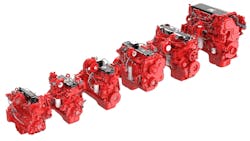Cummins Launches EGR-Free Stage V Engine Lineup at Bauma
Cummins this week at Bauma introduced a new generation of ultra-low-emissions engines from 100 hp to 430 hp designed to meet 2019 European Union Stage V emissions regulations with simpler, EGR-free architecture and Single Module after-treatment technology. The newly named F3.8, B4.5, B6.7 and L9 engines leap ahead of their Stage IV/Tier 4 Final equivalent engines with more than 10-percent more power and almost 20 percent more torque averaged across the range.
"Removing Exhaust Gas Recirculation (EGR) allowed us to realize the full potential of the engine for Stage V without increasing displacement size,” said Jim Fier, Cummins vice-president engineering. “Our 12-liter engine already pointed the way forward for a successful EGR- free design at Stage IV, so we were able to cascade this simpler approach down through the power range. No EGR also means there is less to cool, which will help lower the cost of OEM integration."
Improvements to fuel efficiency will result in the overall fluid cost of the new Stage V engines reducing by 3 percent on average depending on application, compared to those of Stage IV. The engine operating costs will be further reduced with an achievable 1,000-hour oil change interval, twice as long as the current 500 hours.
Smarter electronics will bring Start-Stop technology imbedded in the engine management system, offering the potential to realize fuel savings of between 5 percent and 15 percent, corresponding to the amount of equipment idle time. Cummins Stage V engines are enabled for wireless connectivity, ready to deliver instant, expert engine diagnostics over the air so operators can maximize the uptime availability of their equipment.
"Each one of these new engines is intended to set a new benchmark in its class by providing unprecedented levels of performance and will come with the ability to transform the productivity of equipment for Stage V applications," said Fier.
Enhanced performance combined with simplicity is further reflected in the use of a single Cummins turbocharger on the Stage V engines range. The latest high-efficiency wastegate turbocharging is used for the F3.8, B4.5 and L9 engine. The B6.7 retains proven variable-geometry technology, with the Holset VGT(R) achieving exceptional power density with fuel-efficient performance.
The 4-cylinder F3.8 and B4.5 engines achieve remarkable increases in power and torque for Stage V, enabling significant opportunities for OEMs to downsize engine installations. The 3.8-liter moves from 130 hp (97 kW) at Stage IV up to 155 hp (116 kW) at Stage V, while the 4.5-liter engine jumps from 173 hp (129 kW) to 200 hp (149 kW). Peak torque of the F3.8 increases by more than 20 percent, to 600 N•m, and an 11 percent increase moves the B4.5 up to 780 N•m.
The Stage V regulations to be introduced by EU countries will bring extremely stringent emissions regulations for construction, mining and material-handling equipment, commencing Jan. 1, 2019. The key requirement for Stage V is a Particulate Number (PN) count of 1012/kW-hr - the maximum amount emitted for each kW of engine output per hour. The amount of particulate matter (PM) emitted by weight will reduce to just 0.015 g/kW-hr.
The Cummins Single Module for Stage V combines DPF, SCR and urea-dosing technologies in one module, providing an up to 50 percent reduction in envelope size and a 30 percent reduction in weight compared with those of Stage IV exhaust after-treatment.
While meeting the more stringent Stage V regulations in 2019, the new engines will also be co-certified to meet Tier 4 Final and equivalent emissions regulations in Japan and South Korea. That will make available the benefits of the EGR-free engines to help OEMs reduce the complexity involved with powering their global equipment platforms.
